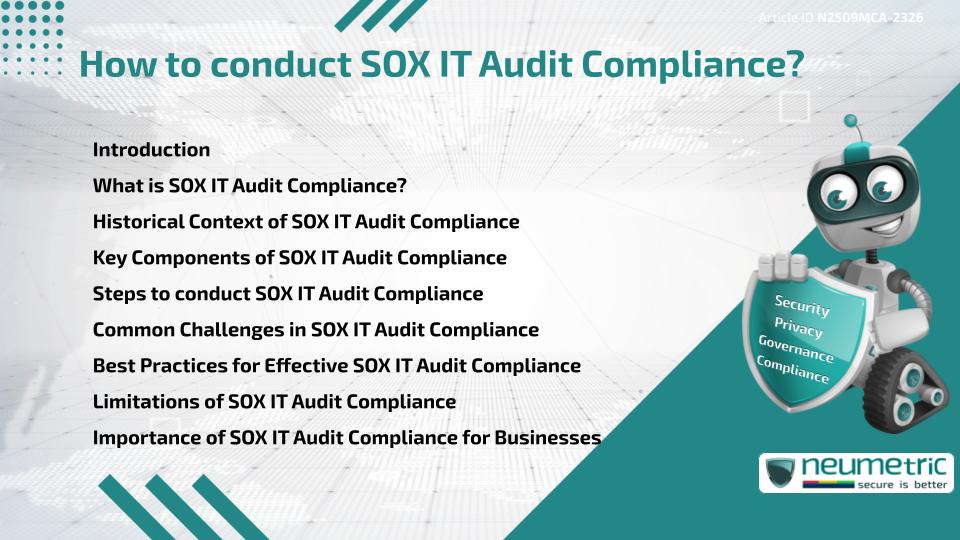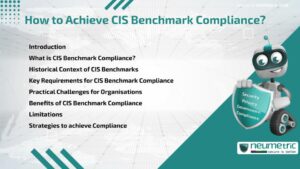Table of Contents
ToggleIntroduction
SOX IT Audit Compliance is a critical process that ensures businesses maintain Transparency, Accuracy & Accountability in their Financial reporting systems. It is part of the Sarbanes-Oxley [SOX] Act, a United States law designed to protect Investors & the public from fraudulent accounting activities. Conducting a SOX IT Audit Compliance involves evaluating information technology Controls, reviewing Data Security practices & ensuring Financial Data Integrity. This article explains what SOX IT Audit Compliance is, its historical background, the steps to conduct it, common challenges & Best Practices for effective implementation.
What is SOX IT Audit Compliance?
SOX IT Audit Compliance refers to the Audit procedures that validate whether a company’s IT systems comply with the requirements of the Sarbanes-Oxley Act. The law emphasises the Accuracy & Reliability of Financial reporting & since most data is stored & processed electronically, IT controls play a vital role. For example, controls around Access Management, Data Backups & Change Management are examined to ensure the Security & Accuracy of Financial data.
Historical Context of SOX IT Audit Compliance
The Sarbanes-Oxley Act was enacted in 2002 after corporate scandals involving Enron & WorldCom. These scandals revealed widespread accounting fraud, leading to the creation of strict measures to safeguard Financial reporting. Section 404 of the Act specifically requires management & external Auditors to report on the adequacy of a company’s internal control over Financial reporting, which includes IT systems. Thus, SOX IT Audit Compliance became an essential practice for companies listed on US stock exchanges.
Key Components of SOX IT Audit Compliance
SOX IT Audit Compliance generally involves four critical areas:
- Access Controls: Ensuring only authorised personnel can access sensitive Financial data.
- Change Management: Monitoring & Documenting system changes to prevent unauthorised alterations.
- Data Security: Protecting Financial Information against breaches, loss or corruption.
- IT Operations: Maintaining reliable system performance, backups & Disaster Recovery.
These components ensure Financial Information remains accurate, complete & secure.
Steps to conduct SOX IT Audit Compliance
Conducting SOX IT Audit Compliance typically follows these steps:
- Define Scope: Identify Financial applications, databases & systems relevant to SOX.
- Assess Risks: Evaluate which systems pose Risks to Financial reporting accuracy.
- Document Controls: Maintain clear documentation of IT controls & Processes.
- Test Controls: Perform testing to verify effectiveness of IT controls.
- Remediate Gaps: Address weaknesses or failures found during testing.
- Report Findings: Provide Audit results to management & external Auditors.
By following these steps, companies can demonstrate their compliance with SOX requirements.
Common Challenges in SOX IT Audit Compliance
Organisations often face challenges such as:
- Complex IT environments with multiple systems.
- Insufficient documentation of Controls.
- Lack of skilled personnel for Auditing.
- High costs of maintaining Compliance.
These challenges can lead to inefficiencies or non-compliance if not addressed effectively.
Best Practices for Effective SOX IT Audit Compliance
To improve compliance efforts, businesses should:
- Automate testing of IT controls where possible.
- Regularly update Policies & Procedures.
- Train staff on SOX requirements & IT security.
- Collaborate closely with external Auditors.
- Perform Continuous Monitoring instead of relying solely on annual Audits.
These practices not only improve compliance but also strengthen overall IT Governance.
Limitations of SOX IT Audit Compliance
While SOX IT Audit Compliance improves Accountability, it has limitations. It cannot guarantee complete prevention of fraud or system errors. It also does not cover non-Financial systems, meaning Risks outside of Financial reporting may remain unaddressed. Additionally, smaller Organisations may find Compliance resource-intensive, as the cost of Audits can outweigh perceived benefits.
Importance of SOX IT Audit Compliance for Businesses
SOX IT Audit Compliance is more than a legal requirement; it builds Trust with Investors, Stakeholders & the Public. By ensuring Financial Data Integrity, businesses demonstrate Accountability & Transparency. This strengthens investor confidence & protects companies from reputational & Financial damage.
Takeaways
- Ensures Accuracy, Security & Reliability in Financial reporting.
- Involves Defining Scope, assessing Risks, Documenting, Testing & reporting Controls.
- Common challenges include complex systems, documentation gaps, high costs & limited expertise.
- Best Practices include Automation, Continuous Monitoring, Policy updates & Staff training.
- Builds Trust with Investors & strengthens IT Governance.
FAQ
What does SOX IT Audit Compliance mean?
It means evaluating IT controls to ensure Compliance with the Sarbanes-Oxley Act’s requirements for Financial reporting Accuracy & Security.
Who needs to follow SOX IT Audit Compliance?
Publicly traded companies in the United States must comply with SOX requirements, which include IT Audit Compliance.
What are the key areas of SOX IT Audit Compliance?
The main areas include Access Controls, Change Management, Data Security & IT operations.
How often should SOX IT Audit Compliance be conducted?
It is generally conducted annually, but many Organisations also use Continuous Monitoring for better control.
What challenges arise in SOX IT Audit Compliance?
Challenges include complex systems, poor documentation, high costs & a shortage of skilled professionals.
Does SOX IT Audit Compliance apply to small companies?
Smaller public companies also need to comply, but they may qualify for simplified reporting requirements.
Can SOX IT Audit Compliance prevent fraud entirely?
No, it reduces Risks but cannot eliminate all possibilities of fraud or system manipulation.
Need help for Security, Privacy, Governance & VAPT?
Neumetric provides organisations the necessary help to achieve their Cybersecurity, Compliance, Governance, Privacy, Certifications & Pentesting needs.
Organisations & Businesses, specifically those which provide SaaS & AI Solutions in the Fintech, BFSI & other regulated sectors, usually need a Cybersecurity Partner for meeting & maintaining the ongoing Security & Privacy needs & requirements of their Enterprise Clients & Privacy conscious Customers.
SOC 2, ISO 27001, ISO 42001, NIST, HIPAA, HECVAT, EU GDPR are some of the Frameworks that are served by Fusion – a SaaS, multimodular, multitenant, centralised, automated, Cybersecurity & Compliance Management system.
Neumetric also provides Expert Services for technical security which covers VAPT for Web Applications, APIs, iOS & Android Mobile Apps, Security Testing for AWS & other Cloud Environments & Cloud Infrastructure & other similar scopes.
Reach out to us by Email or filling out the Contact Form…





